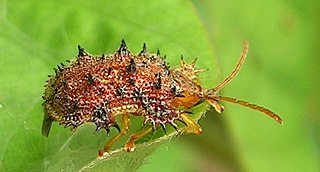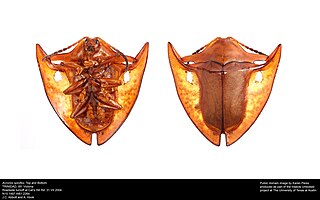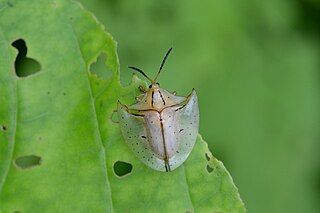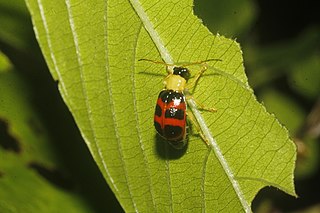
The insects of the beetle family Chrysomelidae are commonly known as leaf beetles, and include over 37,000 species in more than 2,500 genera, making up one of the largest and most commonly encountered of all beetle families. Numerous subfamilies are recognized, but the precise taxonomy and systematics are likely to change with ongoing research.

Sociality is the degree to which individuals in an animal population tend to associate in social groups (gregariousness) and form cooperative societies.

The Chrysomelinae are a subfamily of leaf beetles (Chrysomelidae), commonly known as broad-bodied leaf beetles or broad-shouldered leaf beetles. It includes some 3,000 species around the world.

The Eumolpinae are a subfamily of the leaf beetles, or Chrysomelidae. It is one of the largest subfamilies of leaf beetles, including more than 500 genera and 7000 species. They are oval, and convex in form, and measure up to 10 mm in size. Typical coloration for this subfamily of beetles ranges from bright yellow to dark red. Many species are iridescent or brilliantly metallic blue or green in appearance.

The Cassidinae are a subfamily of the leaf beetles, or Chrysomelidae. The antennae arise close to each other and some members have the pronotal and elytral edges extended to the side and covering the legs so as to give them the common name of tortoise beetles. Some members, such as in the tribe Hispini, are notable for the spiny outgrowths to the pronotum and elytra.

Cassida is a large Old World genus of tortoise beetles in the subfamily Cassidinae. The natural history of Cassida sphaerula in South Africa is a typical life cycle. Several species of Cassida are important agricultural pests, in particular C. vittata and C. nebulosa on sugar beet and spinach. The thistle tortoise beetle has been used as a biological control agent against Canada thistle.

Acromis spinifex is a species of tortoise beetle from South America. The males have enlarged elytra which are probably used in male–male combat, while females are among the few tortoise beetles to show maternal care of their offspring.

Calligrapha is a genus of large American Chrysomelinae of imprecise taxonomic boundaries. Most species occur in Central and South America.

Eumolpini is a tribe of leaf beetles in the subfamily Eumolpinae. It is the largest tribe in the subfamily, with approximately 170 genera found worldwide. Members of the tribe almost always have a longitudinal median groove on the pygidium, which possibly helps to keep the elytra locked at rest. They also generally have a subglabrous body, as well as appendiculate pretarsal claws.

Calligrapha multipunctata, the common willow calligrapha, is a species of leaf beetle in the family Chrysomelidae. It is found in North America.
Pteleon is a genus of leaf beetles in the family Chrysomelidae. There are at least three described species in Pteleon.
Cadiz is a genus of leaf beetles in the subfamily Chrysomelinae, found in North America. It contains only one species, Cadiz hardyi, which was described from the Cadiz Dunes in San Bernardino County, California.

Hemisphaerota is a genus in the subfamily Cassidinae in the family Chrysomelidae. There are about 10 described species in Hemisphaerota.

Calligrapha serpentina, the globemallow leaf beetle, is a species of leaf beetle in the family Chrysomelidae. It is found in Mexico and the United States.

Dematochroma is a genus of leaf beetles in the subfamily Eumolpinae. It is mostly distributed in New Caledonia, though it is also found on Lord Howe Island, Norfolk Island and Timor. Adult beetles are often found at night feeding on leaves, and the larvae eat roots.

Monolepta is a genus of skeletonizing leaf beetles in the family Chrysomelidae. It is the most diverse and widely distributed genus in the Galerucinae sensu stricto, with more than 700 described species occurring almost worldwide. It is missing from the Nearctic realm.

Acromis is a genus of beetles belonging to the family Chrysomelidae. The three species of this genus are found in Southern America. These species exhibit subsociality, where the females lay clusters of eggs that she guards until they hatch, the larvae mature, pupate, and young adults disperse.
The Neotropical tortoise beetle tribe Spilophorini comprises two genera, Calyptocephala Chevrolat, 1836 and Spilophora Boheman, 1850. Biological information is limited but the life cycle includes six larval instars and the larvae construct a shield of their cast skins.

Gynandrobrotica is a genus of skeletonizing leaf beetles in the family Chrysomelidae, found in the Neotropics. The genus contains at least 13 species.

Doryphora is a genus of leaf beetles in the family Chrysomelidae. It includes nine species from Central and South America.

















